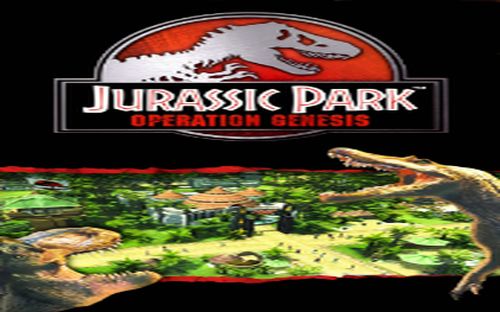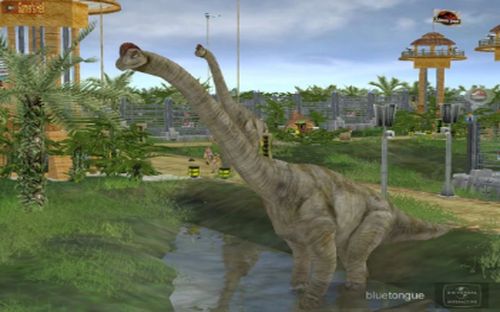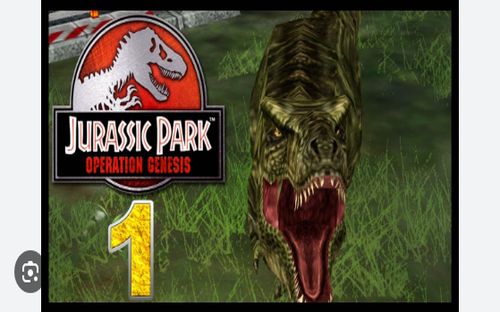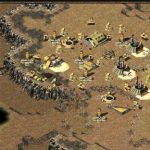In the construction and management simulation game Jurassic Park: Operation Genesis, players take on the exciting challenge of creating and running their own Jurassic Park. The game, which was produced by Universal Interactive and released by Blue Tongue Entertainment in 2003, lets players take on the role of a park administrator entrusted with building a profitable dinosaur theme park. The game, which draws inspiration from the renowned Jurassic Park series, brilliantly conveys the thrill, awe, and inherent peril of reviving ancient animals. Choosing which dinosaurs to clone and handling crises like dinosaur outbreaks and storms require players to continuously strike a balance between visitor happiness, safety, and revenue.
The potential to use retrieved DNA samples to bioengineer more than 20 distinct dinosaur species is the foundation of Operation Genesis. In order to extract DNA in the lab, players must dispatch teams of fossil hunters to different dig sites throughout the globe and gather fossils. More accurate and durable dinosaurs can be cloned as the proportion of viable DNA rises. In order to increase the number of attractions in their park, players can invest in scientific research through this system’s lucrative gaming cycle. Because every dinosaur species has unique social dynamics, ecological requirements, and behaviors, careful park planning is crucial to preventing mayhem.

Three main components of the game are park construction, dinosaur control, and tourist pleasure. In addition to infrastructure like walkways and security systems, players may build enclosures, observation decks, dining options, and retail stores. Every element plays a crucial role; for instance, bigger or more aggressive species require stronger fencing to be contained, while strategically located facilities raise park ratings and visitor satisfaction. A star rating system that ranges from one to five stars is used to gauge the player’s achievement. It decides access to advanced features and represents the park’s quality and safety.
The game’s crisis management features are one of its distinctive features. Players have to be ready for anything from tropical hurricanes that can destroy fences and structures to illness breakouts among the dinosaurs. The most exciting of all are dinosaur escapes, particularly when carnivores like velociraptors or Tyrannosaurus rex escape. Although ranger helicopters can be used by players to calm and catch wild dinosaurs, if these circumstances are not handled quickly, visitor injuries or deaths might result in the park’s rating falling. The typically meticulous simulation gaming is made more tense and unpredictable by these high-stakes situations.
Jurassic Park: Operation Genesis has two additional sandbox modes: Mission Mode and Site B Mode. Players must complete a number of unique tasks in Mission Mode, such stopping a raging dinosaur or defending visitors during a storm. These missions encourage strategic thinking and assess the player’s understanding of the game’s mechanics. In contrast, Site B Mode is more laid-back, akin to The Lost World, and lets players establish a dinosaur refuge without having to worry about visitors, fencing, or revenue. Players who like to observe dinosaurs interact in their natural habitat without any managerial pressure love this option.
For its time, the game’s graphics were regarded as stunning, particularly the way dinosaurs were portrayed. Every species was meticulously portrayed, complete with distinctive noises, movements, and behavioral traits. It’s still fascinating to watch a band of raptors plan a hunt or see a Brachiosaurus extend its neck to munch on trees. Even if the surroundings and landscape are more primitive by today’s standards, the visual presentation effectively captures the majesty of the park idea and the ancient ambiance.



With an orchestral soundtrack evoking John Williams’ original Jurassic Park music, the sound design heightens the immersive experience. A vibrant and dynamic environment is produced by ambient noises like the rustling of trees, the hum of visitor activity, and of course, the frightful roars of dinosaurs. The advisers that offer advice throughout gaming have passable voice acting that gives useful hints without becoming overbearing. Together with the visual components, the total audio experience creates the impression that a live, breathing dinosaur park is being operated.
System Requirements OF Jurassic Park Operation Genesiss Highly Compressed PC
| Ram | SDRAM |
|---|---|
| Processor | Pentium III 500 MHz |
| Accessories | Keyboard, mouse, and speaker |
| Graphics card | 1 GB |
| Windows | Xp, 7, 8, 8.1, 10, and 11 |
| Free disk space | 245 MB |
Despite its initial lackluster reception, Operation Genesis has subsequently grown to become a cult favorite among simulation game and Jurassic Park enthusiasts. It is a highly sought-after title in part because of its restricted availability and the fact that it was never re-released on contemporary platforms. Devoted fan bases have produced tools and modifications that increase the game’s functionality, adding additional dinosaur species, enhancing graphics, and increasing the replay value. Often hailed as a positive, the game’s simplicity in comparison to more recent management simulators offers complexity without overwhelming the user.
Modern video games such as Jurassic World Evolution, which acts as a spiritual sequel, carry on the heritage of Jurassic Park: Operation Genesis. Many fans continue to return to Operation Genesis because of its charm, balance, and sentimental value, even though more recent games have sophisticated visuals and intricate mechanisms. Even people who are not familiar with simulation games can enjoy it because of its user-friendly UI and fun gameplay loop. Few other games have been able to successfully reproduce the combination of strategy and creativity that the game embodies for those who grew up playing it.
Finally, among simulation and park management games, Jurassic Park: Operation Genesis continues to be a notable game. Its gameplay, which depicts the thrill and peril of playing god with nature, perfectly embodies the spirit of the Jurassic Park universe in addition to its graphics and branding. The game provides an engrossing experience that endures astonishingly well even decades after its debut, regardless of whether you’re a seasoned fan returning to Isla Nublar or a newbie experiencing the thrill for the first time.


